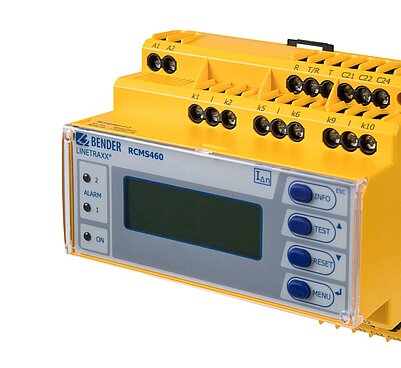

An IT environment requires either an in-house server room or a service from an external data center operator. This server room must be easily accessible and the power supply must be secured so that it is fail-safe. Monitored power distribution boards have active measured value recording and AC/DC sensitive fault current monitoring to optimize energy use and protect against unwanted interruptions of power circuits. User-definable threshold values and local or remote alarms highlight and warn of any errors and reduce the risk of unwanted shutdown or overloading of power circuits. They record fault current monitoring and energy consumption data and are available in real time, so that data center managers can make sound decisions regarding necessary maintenance measures, load distribution and the correct sizing of the IT environments and thus reduce overall operating costs. According to the BITKOM planning guide for operationally safe data centers, one or more ground-fault monitoring systems must be used in the feed to the racks in order to guarantee continuous monitoring without shutdown. All information collected by the RCMS is then forwarded via a gateway to a permanently manned office, e.g. the control center. Alternately, there are also PDUs with built-in Bender intelligence, e.g. from Bachmann.
| Name | Category | Size | Language | Timestamp | D-/B-Number |
|---|---|---|---|---|---|
| Power Quality/Measuring and monitoring relays | Product Overviews | 2.7 MB | EN | 2022/05/2525.05.2022 | |
| Product Overview - Residual Current Monitoring | Product Overviews | 8.0 MB | EN | 2025/04/0202.04.2025 | |
| Power Quality | Flyers | 468.0 KB | EN | 2022/12/1414.12.2022 | |
| Data Centres | Market Segment Brochures | 2.1 MB | EN | 2025/04/3030.04.2025 | |
| DATEV eG Achieves Higher Data Center Availability and Reduces Downtime Through the Application of Bender Residual Current Monitoring Technology | Technical Information | 913.0 KB | EN | 2019/05/1313.05.2019 | |
| Uniterrupted Security | Technical Article | 2.1 MB | EN | 2019/05/1313.05.2019 | |
| Residual Current Monitoring for IT Computing Devices | Flyers | 753.4 KB | EN | 2019/05/1313.05.2019 |
Products

Multi-channel AC/DC ground-fault monitor

Multi-channel AC/DC ground-fault monitor with individual relay outputs

Multichannel AC, pulsed DC and AC/DC sensitive ground-fault monitor

Multichannel AC, pulsed DC and AC/DC sensitive ground-fault monitor with one alarm contact per channel
![[Translate to Canadian English:] LINETRAXX® CTUB100 Series](/fileadmin/_processed_/0/d/csm_CTUB10x-CTBCx_WEB_SI_d8b0d156d2.jpg)
AC/DC sensitive measuring current transformer (Type B)
![[Translate to North American English:] COMTRAXX® COM465IP](/fileadmin/_processed_/f/d/csm_COM465IP_01_WEB_296d1e7f5c.jpg)
Condition Monitor with an integrated gateway for the connection of Bender devices to Ethernet-TCP/IP networks

Recognizing connections – optimizing maintenance

Universal measuring device with numerous measured quantities, energy and power measurement with storage, Power Quality Monitoring, limit value monitoring with alarm forwarding

Multi-channel AC/DC ground-fault monitor

Multi-channel AC/DC ground-fault monitor with individual relay outputs

Multichannel AC, pulsed DC and AC/DC sensitive ground-fault monitor

Multichannel AC, pulsed DC and AC/DC sensitive ground-fault monitor with one alarm contact per channel
![[Translate to Canadian English:] LINETRAXX® CTUB100 Series](/fileadmin/_processed_/0/d/csm_CTUB10x-CTBCx_WEB_SI_d8b0d156d2.jpg)
AC/DC sensitive measuring current transformer (Type B)
![[Translate to North American English:] COMTRAXX® COM465IP](/fileadmin/_processed_/f/d/csm_COM465IP_01_WEB_296d1e7f5c.jpg)
Condition Monitor with an integrated gateway for the connection of Bender devices to Ethernet-TCP/IP networks

Recognizing connections – optimizing maintenance

Universal measuring device with numerous measured quantities, energy and power measurement with storage, Power Quality Monitoring, limit value monitoring with alarm forwarding
Errichten von Niederspannungsanlagen - Teil 7-731: Anforderungen für Betriebsstätten, Räume und Anlagen besonderer Art – Abgeschlossene elektrische Betriebsstätten
Environmental Engineering (EE); Earthing and bonding of 400 VDC Data and Telecom (ICT) Equipment - Erdung und Potentialausgleich von Einrichtungen der Informations- und Kommunikationstechnik mit DC 400 V in Rechenzentren und in Betriebsgebäuden der Telekommunikationstechnik (Anerkennung der Englischen Fassung EN 301 605 V1.1.1 (2013-10) als Deutsche Norm)